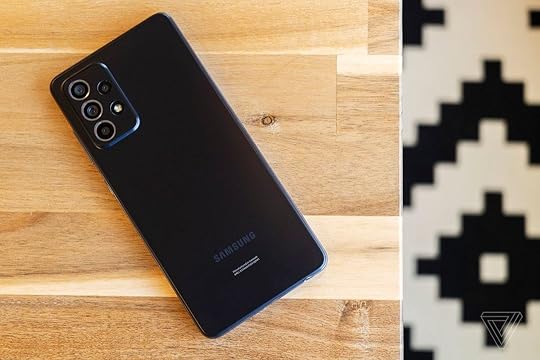Dominique Luchart's Blog, page 599
June 10, 2021
Frontier Communications is getting sued by record labels for not disconnecting pirates,

Frontier Communications, an ISP that serves around 3 million subscribers, has been sued by Warner, Sony, and Universal’s record labels for allegedly not taking action against its users who pirate music (via Ars Technica).
The record labels allege in their complaint (PDF) that not only did Frontier fail to disconnect people who repeatedly pirated, but it even encouraged them by advertising the ability to “download 10 songs in 3.5 seconds” and profited from the result. The labels also allege that Frontier ignored its subscribers’ piracy so it could keep collecting subscription fees, saying that the ISP valued profit over legal responsibility.
Frontier denies wrongdoing, telling The Verge that it has terminated customers when copyright holders complain. The ISP plans to “vigorously defend itself.”
The suit, which was filed in the state of New York, seeks damages from Frontier for its subscribers who have infringed on almost 3,000 copyrighted works after the ISP was repeatedly told about their infringement. A list of pirated songs (PDF) includes Thank U, Next by Ariana Grande, Verge (no relation to this publication) by Owl City, and Rich as Fuck by Lil Wayne featuring 2 Chainz.
The labels are seeking $300,000 per infringement, which would put the ISP on the hook for over $850 million. It’s worth noting that Frontier Communications emerged from chapter 11 bankruptcy last month — having to pay that much in damages wouldn’t be good for any company, but especially not one that’s just getting out of that situation.
Warner, Sony, and Universal have also sued other ISPs like Charter and Cox on similar grounds, winning a $1 billion award from the latter (though that case is still going through the appeals process). And over the past 20 years, the music industry has tried different approaches to curb online piracy, from suing individuals to working with ISPs to set up a strike system.
The approaches haven’t been particularly effective and have largely been abandoned, and it’s hard to foresee the tactic of suing ISPs working to stop music piracy. And, as Ars Technica points out, ISPs being forced to cut off pirates could affect other people living with them as well, denying entire households access to a fundamental part of modern day life.
The post Frontier Communications is getting sued by record labels for not disconnecting pirates, appeared first on NEWDAWN Blog.
Google is fighting back against exploitative, slanderous websites,

Google is updating its search algorithms to prevent sites from filling search results with unproven slanderous claims about individuals, The New York Times reports. The changes follow a recent series of reports from the Times, which found a vast web of sites hosting unverified and potentially life-ruining claims about individuals, alongside an industry of other services promising to remove the offending content from search results for substantial fees.
The search giant is making a series of changes to its rankings to combat the sites, which Google’s vice president for global policy and standards and trust and safety David Graff said should eventually have a “significant and positive impact” for those affected. Now, when users report they’ve been a victim of these sites by using its pre-existing process, Google will register that person as a “known victim,” and will automatically “suppress” similar results for that person’s name, the Times says.
It’s an important shift considering how these sites operate, where posts are routinely taken from one site and republished across over a dozen more. The Times even conducted an experiment where it created one such post about its own reporter, only to see an initial crop of five posts spawn 21 more across a network of 15 sites. Google’s changes could help to stop these numerous posts from clogging up search results. The NYT reported that completely taking down the posts would have cost it around $20,000. Individual sites and services reportedly charged upwards of $700 to get each post removed.
Some of the changes have reportedly already come into effect, with more coming in the months ahead, but the Times reports that its own tests have highlighted initial problems with the approach. Although it says posts had “mostly” disappeared for some users, it notes that Google’s changes didn’t appear to have caught a new slander site, which may not have received the volume of complaints to put it on Google’s radar yet. However, for others, the new process appeared to work better, with posts disappearing from the first page of text and image results.
The move represents the latest shift away from Google’s original self-proclaimed role as an impartial provider of results. Back in 2004 the company said its results were “generated completely objectively and are independent of the beliefs and preferences of those who work at Google.” But over the years this position has softened, particularly in light of legislation like the EU’s “right to be forgotten.” It means the company is fulfilling an increasingly important role on the web, even beyond the 90 percent of global searches it currently handles.
The post Google is fighting back against exploitative, slanderous websites, appeared first on NEWDAWN Blog.
This $2,700 robot dog will carry a single bottle of water for you,

Boston Dynamics isn’t the only company that makes futuristic quadrupedal robots. Chinese firm Unitree Robotics has also been at it for years, and this week revealed its latest creation: the Unitree Go1, a robust-looking four-legged bot that’s remarkably cheap, with prices starting at just $2,700. (For comparison, Boston Dynamics’ Spot robot costs $74,500.)
What is the Go1 for, though? Well, a demo video shows it being put to such useful tasks as “following someone on a run” and “carrying a single bottle of water.” Sure it’s not practical to have a robot butler for your phone and wallet, but it makes a statement on a night out.
More realistically, the robotics industry is still exploring the best applications for these sorts of machines. Spot, for example, is currently being tested in areas like industrial inspections and police reconnaissance (with mixed results). Unitree, though, says it wants to make quadrupedal robots as affordable and popular as smartphones and drones. So, a fun demo reel that shows the Go1 just sort of chilling out and looking cool makes perfect sense.
[image error] Incidentally, “hang out without effort” is one of my top desires post-lockdown. Image: Unitree Robotics
Incidentally, “hang out without effort” is one of my top desires post-lockdown. Image: Unitree RoboticsThe company only has a basic spec sheet for the robot on its site, but here’s what we do know. The Go1 comes in three versions: the $2,700 Go1 Air, $3,500 Go1, and $8,500 Go1 Edu. Each weighs about 12kg (26 pounds) and the more expensive models come with more processor power and sensors (the Go1 Edu is the only version with an unspecified programming API). It seems automatic person-following and obstacle-avoidance come standard, though only the pricier models hit the advertised top speed of 17km/h. Unitree doesn’t say anything about battery life, either. Though given that Spot only has enough juice for 90 minutes of operation, we’d say that the “all-day companion” mode suggested by the Go1 demo video is a bit of an artful exaggeration.
At any rate, tech like this shows that quadrupedal robots are quickly turning from novelties to commodities. The real question is: can they also be useful, or will they just be carrying our water for years to come.
The post This $2,700 robot dog will carry a single bottle of water for you, appeared first on NEWDAWN Blog.
iOS 4 has been lovingly recreated as an iPhone app, Tom Warren

 OldOS app on an iPhone. | Photo by Tom Warren / The Verge.
OldOS app on an iPhone. | Photo by Tom Warren / The Verge.iOS 4 originally appeared nearly 10 years ago as Apple’s first mobile operating system to drop the iPhone OS naming convention. An 18-year-old developer has now lovingly recreated iOS 4 as an iPhone app, and it’s a beautiful blast from the past. If you never got the chance to use iOS 4, or you’re a fan of the iPhone 3G, OldOS almost flawlessly pulls off the experience of using an iPhone from a decade ago.
OldOS is “designed to be as close to pixel-perfect as possible,” says Zane, the developer behind the app. It’s all built using Apple’s SwiftUI, so it includes buttery smooth animations and even the old iPhone home button that vibrates with haptic feedback to make it feel like a real button.
Apple’s built-in iOS 4 apps have also been…
The post iOS 4 has been lovingly recreated as an iPhone app, Tom Warren appeared first on NEWDAWN Blog.
iOS 4 has been lovingly recreated as an iPhone app,

iOS 4 originally appeared nearly 10 years ago as Apple’s first mobile operating system to drop the iPhone OS naming convention. An 18-year-old developer has now lovingly recreated iOS 4 as an iPhone app, and it’s a beautiful blast from the past. If you never got the chance to use iOS 4, or you’re a fan of the iPhone 3G, OldOS almost flawlessly pulls off the experience of using an iPhone from a decade ago.
OldOS is “designed to be as close to pixel-perfect as possible,” says Zane, the developer behind the app. It’s all built using Apple’s SwiftUI, so it includes buttery smooth animations and even the old iPhone home button that vibrates with haptic feedback to make it feel like a real button.
Apple’s built-in iOS 4 apps have also been recreated here, and it’s a real flashback to the skeuomorphic days of the iPhone whenever they launch. Photos lets you view your existing camera roll as you would have 10 years ago, while Notes transports you back to the yellow post-it notes of yesteryear.
Today is Launch Day
Introducing OldOS — iOS 4 beautifully rebuilt in SwiftUI.
* Designed to be as close to pixel-perfect as possible.
— Zane (@zzanehip)
* Fully functional, perhaps even usable as a second OS.
* Fully open source for all to learn, modify, and build on. pic.twitter.com/K0JOE2fEKM
The only apps that don’t work as you might expect are Messages and YouTube. Apple used to bundle YouTube directly into its operating system, and the developer behind OldOS says there are “still some major issues with YouTube” and Messages that they’re working to fix.
Everything else is mostly flawless. and you can even browse the web in the old UI of Safari. The App Store also list apps that will redirect you to the modern store to download and install. There are some things that simply don’t work, including folders and no jiggling to rearrange home screen apps.
We’ve seen this type of nostalgic app appear on the iPhone before. Rewound launched in the App Store back in December 2019, turning an iPhone into an iPod. Apple quickly pulled the app a few days later, citing store violations.
This latest OldOS app is available on Apple’s TestFlight service, which is typically used to distribute beta versions of apps. That means it probably won’t last long before Apple takes exception, so grab it while you can. Zane has also published the source code for the entire project on GitHub, so if you’re willing to compile it in Xcode then it will live forever.
The post iOS 4 has been lovingly recreated as an iPhone app, appeared first on NEWDAWN Blog.
How to watch the ‘ring of fire’ solar eclipse online today, ,

Editor’s note: The video feed above of the 2021 “ring of fire” solar eclipse is provided courtesy of TimeandDate.com.
‘Ring of Fire’ solar eclipse 2021
[image error]
(Image credit: Starry Night)If you snap a photo of the 2021 annular solar eclipse let us know! You can send images and comments to spacephotos@space.com.
If you can’t catch the next solar eclipse in person, there are several places where you can watch the event live.
The 2021 “ring of fire” annular solar eclipse on Thursday (June 10) will be partially visible from the United States, northern Canada, Europe, northern Asia, Russia and Greenland, according to Time and Date. Space.com has a detailed guide about how to view the eclipse safely in the United States — make sure never to look at the sun without proper equipment, which is listed in the Space.com article.
If you can’t see the eclipse due to geography, cloudy conditions or quarantine restrictions, several online streams have you covered.
Related:
Visibility maps to see the annular solar eclipse of 2021
More:
When, where and how to see the ‘ring of fire’ solar eclipse of 2021
Today’s best deals on eclipse glasses:
Solar Eclipse Glasses (Pack…
Amazon
$14.99
Lunt Solar Systems Solar…
Amazon
$16.99
Lunt Solar Systems Solar /…
BHPhoto
$44.95
Show More Deals
We check over 130 million products every day for the best prices
Virtual Telescope ProjectThe Virtual Telescope Project, which is based near Rome, will host yet another livestream with international participation from observers in Canada based in Ontario (Toronto, Thunder Bay and Ottawa), British Columbia (Victoria) and New Brunswick (Saint John). The event starts at 4 a.m. EDT (0900 GMT), and you can watch it live on YouTube or via The Virtual Telescope Project’s website.
NASANASA will stream a live webcast showing views of the partial solar eclipse (not the “ring of fire” peak) on NASA TV.
The livestream will begin at 5 a.m. EDT (0900 GMT), but will appear dark until sunrise at 5:47 a.m. EDT (0947 GMT). The webcast is highly dependent on weather, NASA officials said, but will be accessible via the agency’s public NASA TV channel, which you can find on YouTube here.
TimeandDate.com will livestream the eclipse on YouTube at 5 a.m. EDT (1000 GMT) and also has a web page showcasing several streaming partners that will be helping out from the United States and Canada.
Royal Observatory GreenwichIn the United Kingdom, Royal Museums Greenwich (near London) is hosting a livestream from the Royal Observatory, which is the traditionally situated location of the prime meridian. The livestream starts at 5:05 a.m. EDT (1005 GMT) on both Facebook and YouTube.
“Our expert astronomy team will help explain the science of solar eclipses and answer all your space questions,” the observatory said in a statement. “You’ll see exactly the same view as our astronomers, with a live telescope feed of the Sun from our state-of-the-art Annie Maunder Astrographic Telescope.”
The next solar eclipse — which is total in Antarctica and partial in South Africa and the south Atlantic — will take place on Dec. 4, according to NASA. Solar eclipses happen when the moon moves between the Earth and the sun, but due to the small size of our moon compared with our solar neighbor, catching a total eclipse is a relatively rare event.
Editor’s Note: If you snap an amazing night sky picture and would like to share it with Space.com’s readers, send your photos, comments, and your name and location to spacephotos@space.com. This story was updated on June 9 to include NASA’s webcast details.
Follow Elizabeth Howell on Twitter @howellspace. Follow us on Twitter @Spacedotcom and on Facebook.
Join our Space Forums to keep talking space on the latest missions, night sky and more! And if you have a news tip, correction or comment, let us know at: community@space.com.
The post How to watch the ‘ring of fire’ solar eclipse online today, , appeared first on NEWDAWN Blog.
June 9, 2021
Samsung pushes pixel size even further with new camera sensor, Sam Byford

 Photo by Allison Johnson / The Verge
Photo by Allison Johnson / The VergeSamsung has announced a new image sensor for smartphone cameras that it says has the smallest pixels in the industry. The ISOCELL JN1 is a 50-megapixel sensor with a relatively tiny 1/2.76-inch format, meaning its pixels are just 0.64μm in size. For comparison, Samsung already broke records in 2019 with the slightly larger ISOCELL Slim GH1, another 50-megapixel sensor with 0.7μm pixels.
Conventional camera wisdom says that smaller pixels usually result in worse image quality with higher noise, so why is Samsung doing this? According to the company, it’s about form factor versatility. The sensor’s smaller size means it can be used in ultrawide or telephoto camera modules — which are challenging to design when size is at a premium — or as…
The post Samsung pushes pixel size even further with new camera sensor, Sam Byford appeared first on NEWDAWN Blog.
Samsung pushes pixel size even further with new camera sensor,

Samsung has announced a new image sensor for smartphone cameras that it says has the smallest pixels in the industry. The ISOCELL JN1 is a 50-megapixel sensor with a relatively tiny 1/2.76-inch format, meaning its pixels are just 0.64um in size. For comparison, Samsung already broke records in 2019 with the slightly larger ISOCELL Slim GH1, another 50-megapixel sensor with 0.7um pixels.
Conventional camera wisdom says that smaller pixels usually result in worse image quality with higher noise, so why is Samsung doing this? According to the company, it’s about form factor versatility. The sensor’s smaller size means it can be used in ultrawide or telephoto camera modules — which are challenging to design when size is at a premium — or as a way to reduce the height of the primary camera bump.
As with other high-resolution camera sensors, the JN1 will make use of pixel-binning technology that combines multiple pixels into one for higher light sensitivity. In this case, Samsung says the sensor will capture 12.5-megapixel photos with the equivalent of 1.28um pixels, and the company is also claiming a 16 percent boost to light sensitivity with its ISOCELL 2.0 tech.
Unusually, Samsung even held a full-on live-streamed launch event for this sensor, which you can watch here:
[embedded content]Samsung says the JN1 is currently in mass production, so it’s likely to show up in smartphones before too long.
The post Samsung pushes pixel size even further with new camera sensor, appeared first on NEWDAWN Blog.
‘Ring of fire’ solar eclipse 2021: Path, viewing maps and photo guide, ,

Find maps, diagrams and animations of the “ring of fire” solar eclipse on June 10, 2021.
The post ‘Ring of fire’ solar eclipse 2021: Path, viewing maps and photo guide, , appeared first on NEWDAWN Blog.
Sony announces the $9,000 professional drone it teased at CES, Mitchell Clark


Sony is now fully revealing its Airpeak S1 drone, which it teased at CES 2021 in January. The announcement contains a lot more detail on the drone’s capabilities, features, and reveals a $9,000 pricetag for the drone sans gimbal or camera, all of which cements the idea that this drone will be aimed squarely at the professional video market.
Image: SonyThe Airpeak with an A7S and 24mm lens attached to the sold-separately gimbal.
The Airpeak S1 is built to work with Sony’s mirrorless cameras, including the A7S Mark III, FX3, or even the 8K-capable Alpha 1. They’ll be attached to a special version of the Gremsy T3 gimbal that’s been designed specifically for the Airpeak and that you’ll have to buy separately….
The post Sony announces the $9,000 professional drone it teased at CES, Mitchell Clark appeared first on NEWDAWN Blog.



